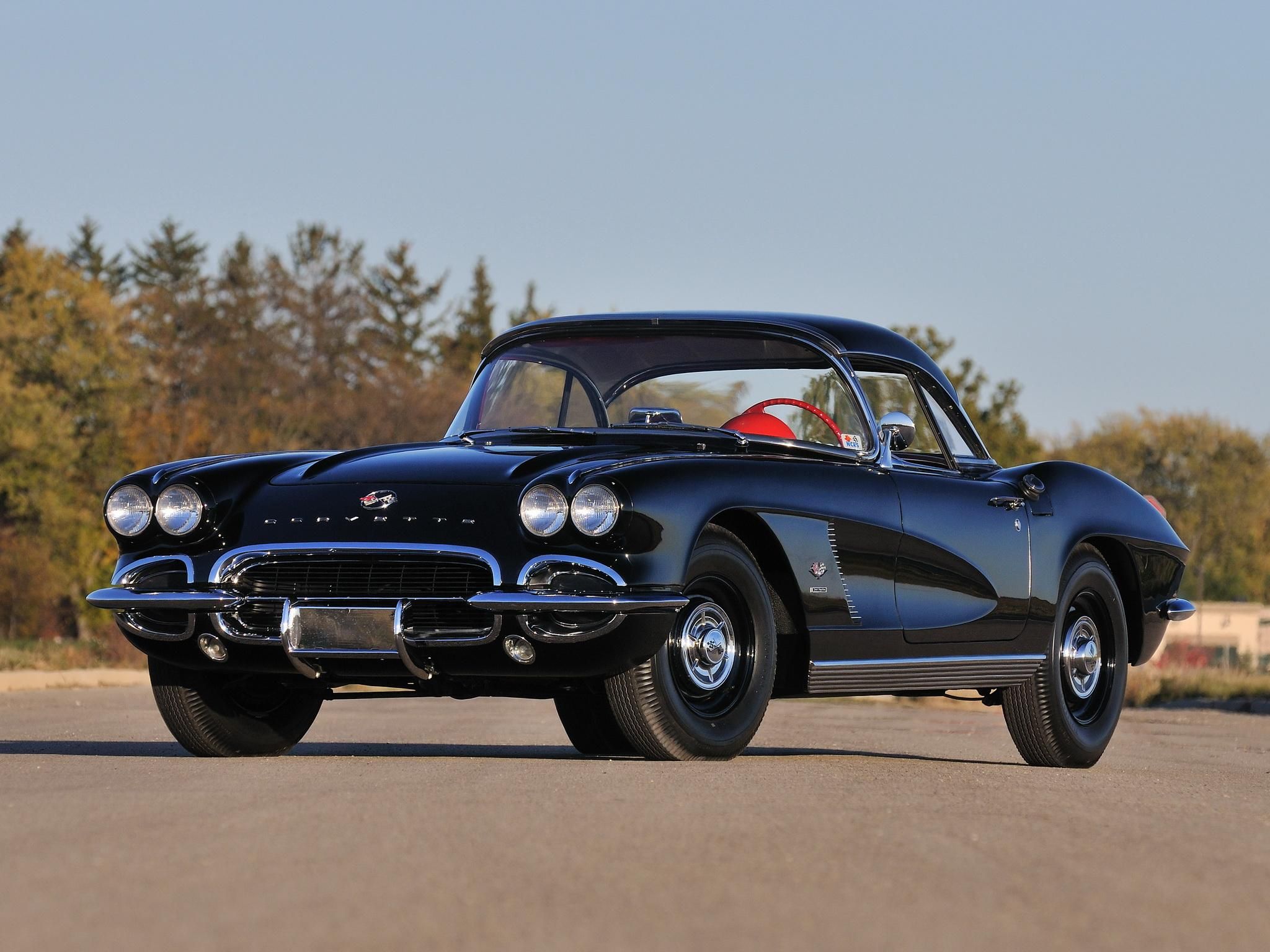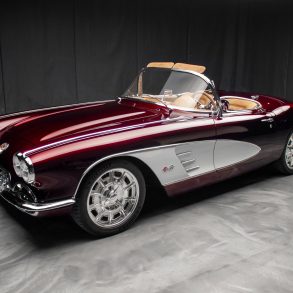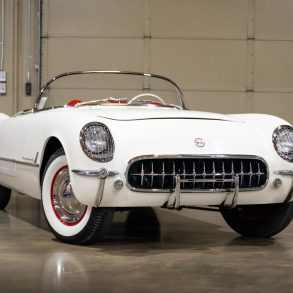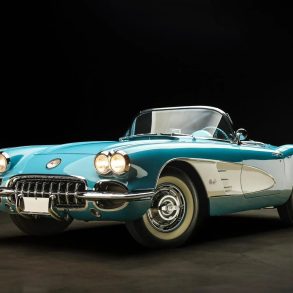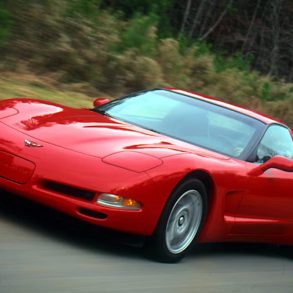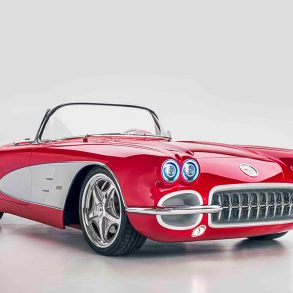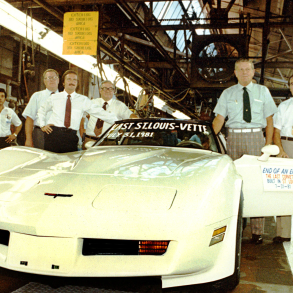Thinking of Buying a C1 Corvette? Here’s What You Need to Know
There are few Corvettes more iconic than the first-generation models from the late 1950s and early 1960s. Spot a C1 on the open road or at a local car show, and you get an immediate rush of Americana. Whether you are eight or eighty years old, the chrome trim and contrasting side coves exude an image of speed. The roar of the car’s cast-iron engine through a set of wrapped headers and glass pack mufflers brings an undeniable smile to our faces as the exhaust note resonates deep within our guts. The smell of high-octane fuel pumping through a pair of four-barrel carburetors awakens memories of more carefree days and nights cruising with friends along the boulevard.
And then an idea hits you….”I have to have one of my very own!!”
Although the idea of purchasing a Corvette has been an aspiration for thousands of drivers of all ages, the idea of purchasing a first-generation Corvette has often been believed to be “out of reach” for many of us. While it’s true that there are some early C1 Corvette out there that are exceedingly rare and therefore prohibitively expensive, the reality is that there are plenty of first-generation Corvettes – especially those built between 1959 and 1961 – that are well within the range of most budgets.
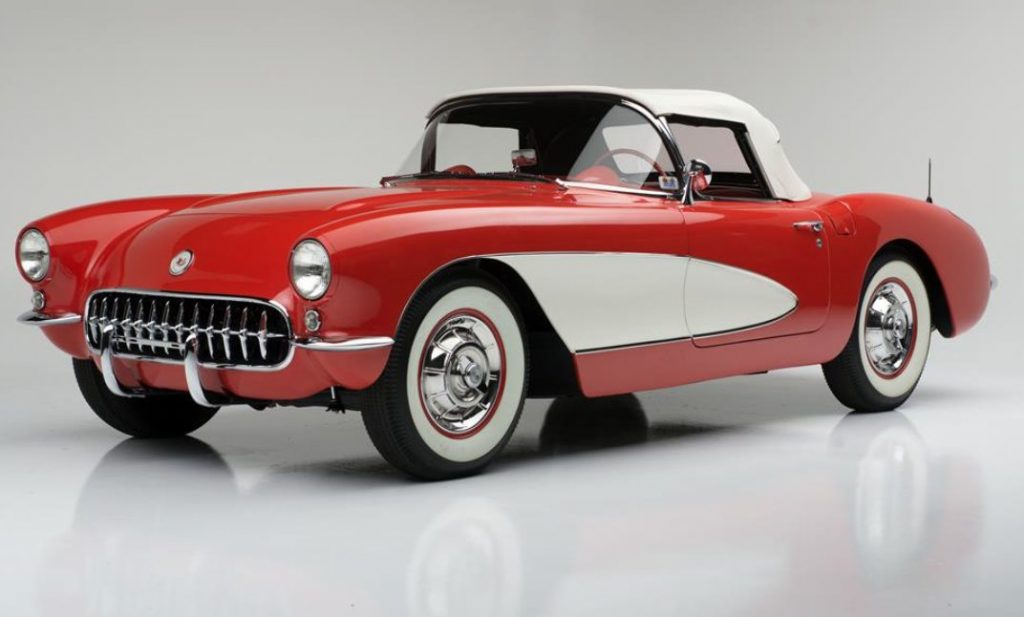
That said, there are a lot of things to consider when purchasing a C1 Corvette. Age, maintenance, and overall condition all play into the car’s value. Considering that the newest C1 Corvette (a 1962 model year example) is still nearly sixty-years old, it is important to know as much about a potential purchase as you can before ponying up the money and making the purchase. The old saying “forewarned is forearmed” definitely holds true here. While you might think you’ve found the best deal on the planet, there’s a lot of cars out there that look good on the surface but are a complete disaster beneath the hood.
It is with this thought in mind that we bring you our C1 Corvette Buyers Guide. Unlike some of the other buyer’s guides on our website, this one will not dive as deeply into the common issues or available options of any given model year, but will instead focus on the items most critical to consider when considering the purchase of a first-generation Corvette. Our hope is that this guide will help future buyers navigate the classic Corvette market so that you’ll find a car that’ll bring you a lifetime of enjoyment without breaking the bank.
Introducing the C1 Corvette
The first-generation (C1) Corvette was introduced in January 1953 in the lobby of the Waldorf-Astoria Hotel in New York City as part of General Motors Motorama show. The car, which was the brainchild of Harley Earl, had been developed by Earl when he took note of U.S. servicemen purchasing small, two-seat sports cars from overseas after returning home from World War II. Earl, who recognized that the American Automotive Industry lacked an automobile that could compete with the European sports cars he was seeing with increased regularity, set to work on his own sports coupe. In less than two-years time, Earl had fully realized his Corvette.
Year-by-Year – What Are the Differences?
1953 Corvette
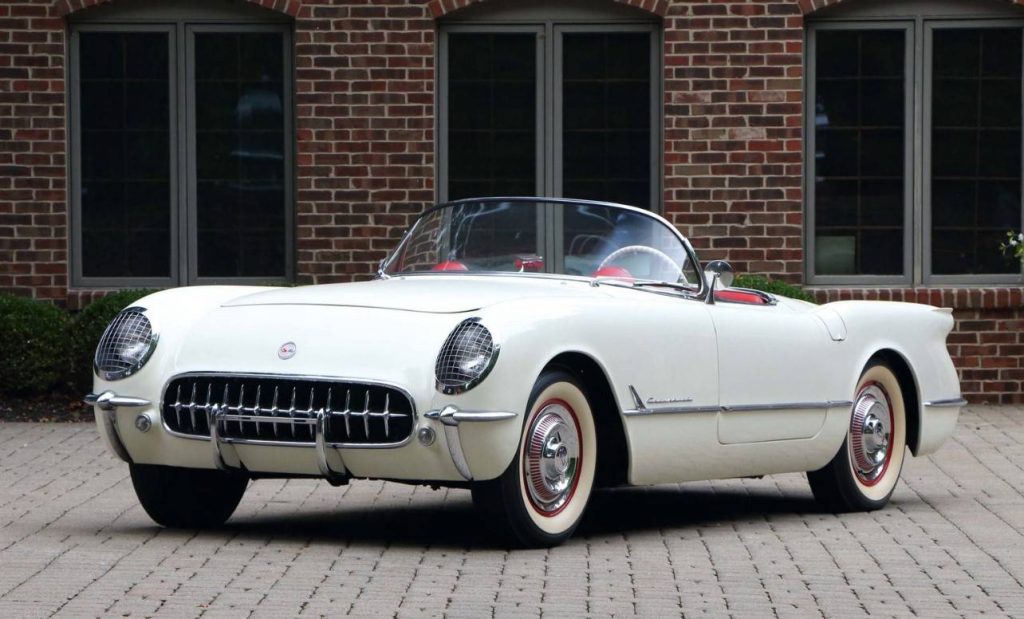
The 1953 Corvette is probably more desirable today than it was when it was new. Because the first MY Corvette was limited to a production run of just 300 units, combined with the fact that 1953 was the first year the car was produced, it is one of the rarest and most sought after / collectible first-generation Corvettes of then all. Of the first 300 1953 Corvettes, approximately 225 are still known to exist today.
All of the 1953 Corvettes produced that first year were painted Polo White and featured a Sportsman Red interior with a black, collapsable top, 6.70 x 15 four ply whitewall tires, a Delco signal-seeking radio, a standard array of analog instruments which included a 5000-rpm tachometer and a counter for total engine revolutions (a feature that would continue through 1959).
The 1953 Corvette featured the “Blue Flame” six-cylinder engine (also known as the “Stovebolt Six“ by the engineering teams at GM). The Stovebolt six-cylinder donor engine was renowned for its reliability but with an engine rating of only 105 horsepower, it lacked the performance and sportiness that people expected from a two-seat sports car. A more radical camshaft, solid lifters, dual valve springs, and a higher compression ratio cylinder head was installed. All of these items contributed to an increased engine output of 150 brake horsepower.
1954 Corvette
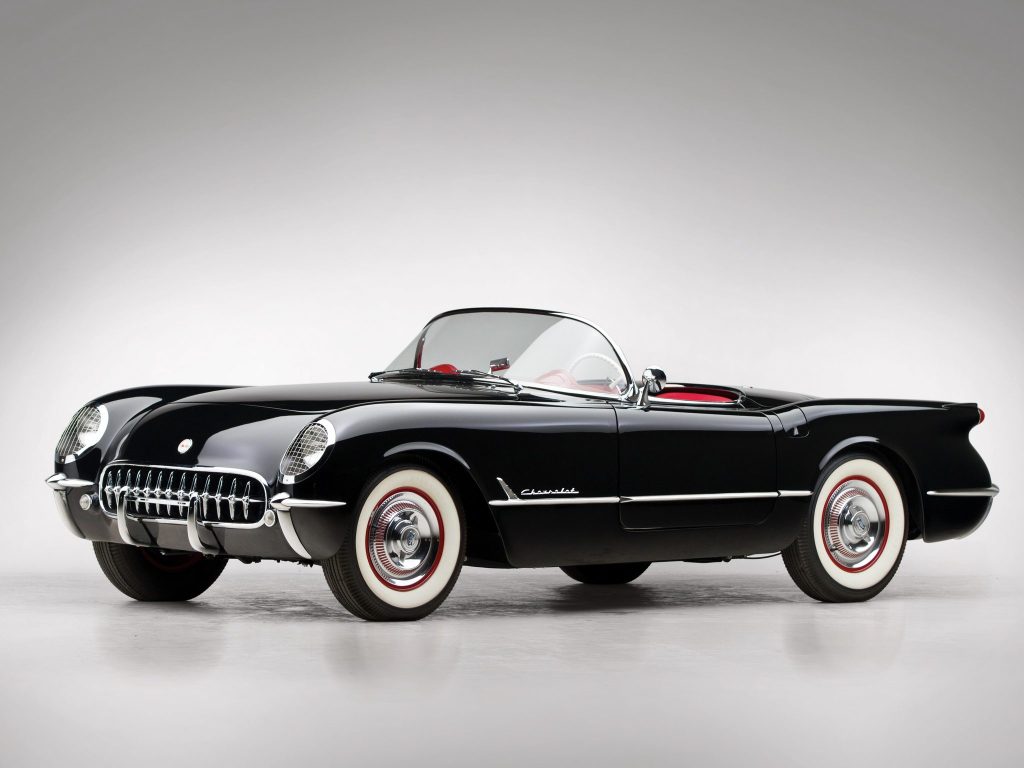
The 1954 Corvette began production in December, 1953. Although the first fourteen or fifteen ‘54 Corvettes were built in Flint, Michigan, GM shifted Corvette’s production to a newly renovated assembly plant in St Louis, Missouri.
There were very few initial design changes between the 1953 and 1954 model Corvettes, although refinements would be made throughout the 1954 production year. The 1954 model had longer exhaust outlets that were run below the car’s body. Other changes included relocating the fuel and brake lines inboard of the right-hand main frame rail, providing them with additional protection. Also, the canvas tops and rails were changed from black to tan. The original two-handle exterior hood latch was replaced by a single handle mechanism after the production of the first 300 (approximate) 1954 models. The choke control was moved from the right to the left of the steering column.
Some additional changes were also made to the engine and drivetrain. The use of a new camshaft increased the total horsepower of the “Blue Flame” six-cylinder engine to 155bhp. Other alterations included a new-style rocker arm (valve) cover (of which approximately 20% were finished in chrome – serial numbers 1363 through 4381 and of which all were now held down by four bolts through the outer lip of the cover instead of two center studs), a better-designed wiring harness, dual air filters, a new type of starter and plastic insulated wire (instead of fabric insulated).
Perhaps the most notable change from the 1953 to 1954 models was the opportunity to purchase a Corvette with a choice of different color options.In 1954, General Motors offered the Corvette to consumers with the following color combinations: Pennant Blue with a Tan interior (which accounted for 16% of the production models made that year), Sportsman Red with a Red Interior (which accounted for a mere 4% of the production models), Polo White with a Red Interior (which accounted for about 80% of the production models).
1955 Corvette
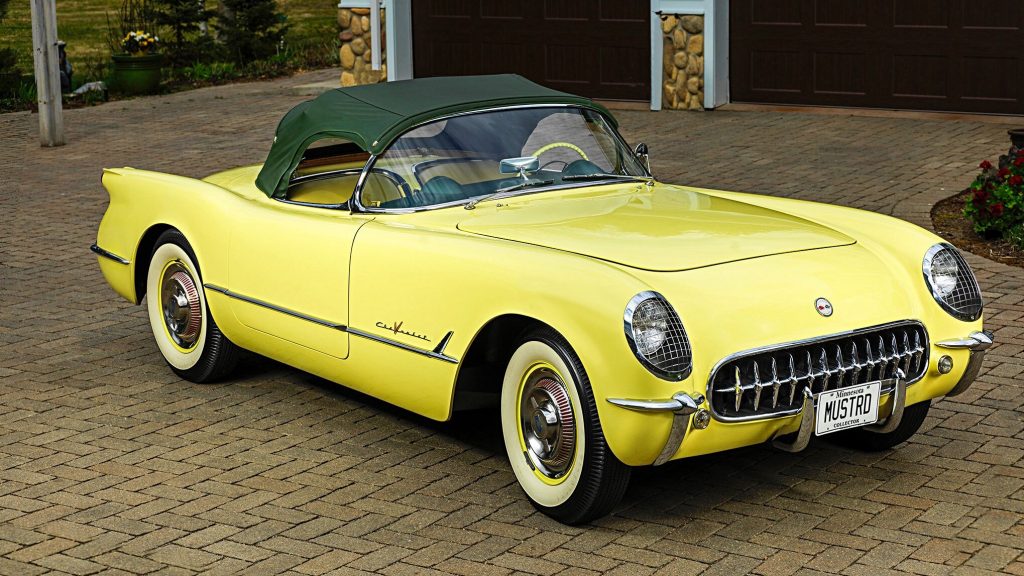
In 1955, GM introduced the new 265-cid small-block V-8 engine. This engine would become the “heart and soul” of the 1955 Corvette. The inclusion of a short-stroke crankshaft allowed the engine to rev to 6,000rpm. Optioned for an extra $135, all but six of the 1955 Corvettes built included this bigger, stronger engine. As an identifier that these new Corvettes contained the larger engine, an exaggerated gold “V” was overlaid on the existing “CheVrolet” logo on the lower front fenders. The car also included a broader radiator grille. The engine featured a special camshaft that produced an additional 33 horsepower above standard tune – resulting in a total of 195 bhp at 5000 rpm.
The Powerglide two-speed automatic remained for most of the 1955 model year. However, approximately 75 cars were built that year with Corvette’s first manual gearbox. This was a new close-ratio three-speed manual transmission which was shifted via a stubby chrome shifter rod capped by a small, white ball and surrounded by a boot that was clamped to the floor by a bright metal ring showing the shift pattern.
Other changes to the car included: an automatic choke as well as a modern 12 volt electrical system, though the older 6-volt system was retained for the few six-cylinder Corvettes that were built that year. Electric wipers replaced vacuum-operated units and foot-operated windshield washers were included. Tires changed from tube type to the tubeless variety and were available in both white wall and black wall versions.
1956 Corvette
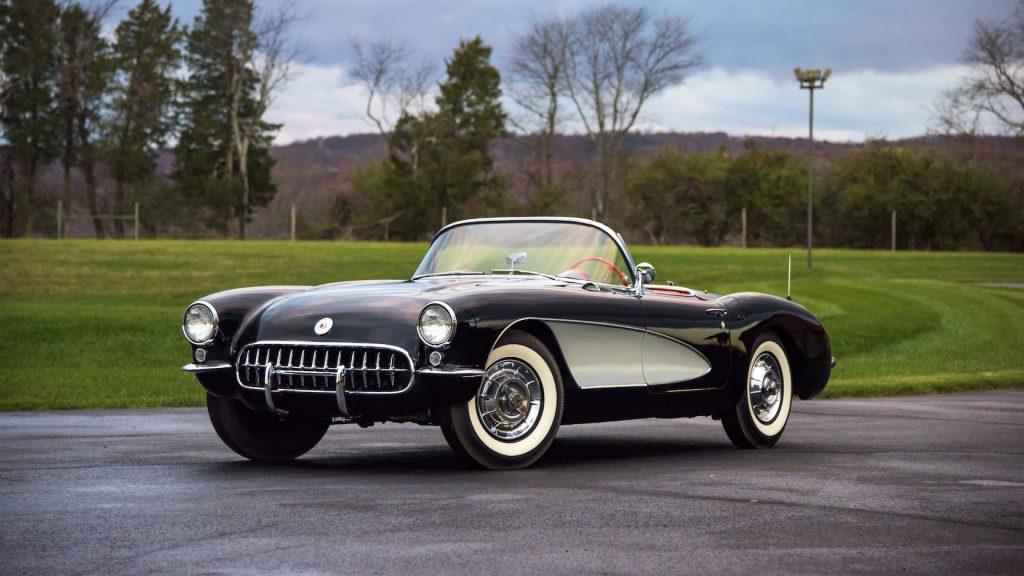
On February 1, 1955, just as the Ford Thunderbirds were beginning to make an appearance on the streets in serious numbers, Earl had all but finalized a full-scale clay model of a new Corvette body. The result of his new design was a 1956 Model Corvette that would change the direction of Corvette sales for all time.
Bodyside “coves” were first introduced on the 1956 Corvette. These coves gave the 1956 Corvette a truly unique styling personality. This new look helped to correct the long, blocky look of the original ‘Vettes and gave the new design an aggressive look and flow that was clean and attractive. To further accentuate the overall styling of the car, the coves were outlined in chrome and were often painted a different color than the rest of the car.
The 1956 Corvette moved the car’s headlights forward and now left them exposed. A larger version of the round Corvette nose emblem was introduced featuring the crossed-flags motif that continues to survive today. The grill would remain unchanged for the 1956 model.
Rear end styling revisions to the Corvette were also performed. The 1953-1955 fenders and jet-pod tail lamps were minimized to more attractive French curves contoured to match the rear deck curvature. New taillights were neatly added above a vertical bumperette on each fender. The trunklid “shadow box” was discarded and the license plate was moved to below the trunk opening. In all, the result was a smooth, gently curved backend with slightly protruding fenders.
1957 Corvette
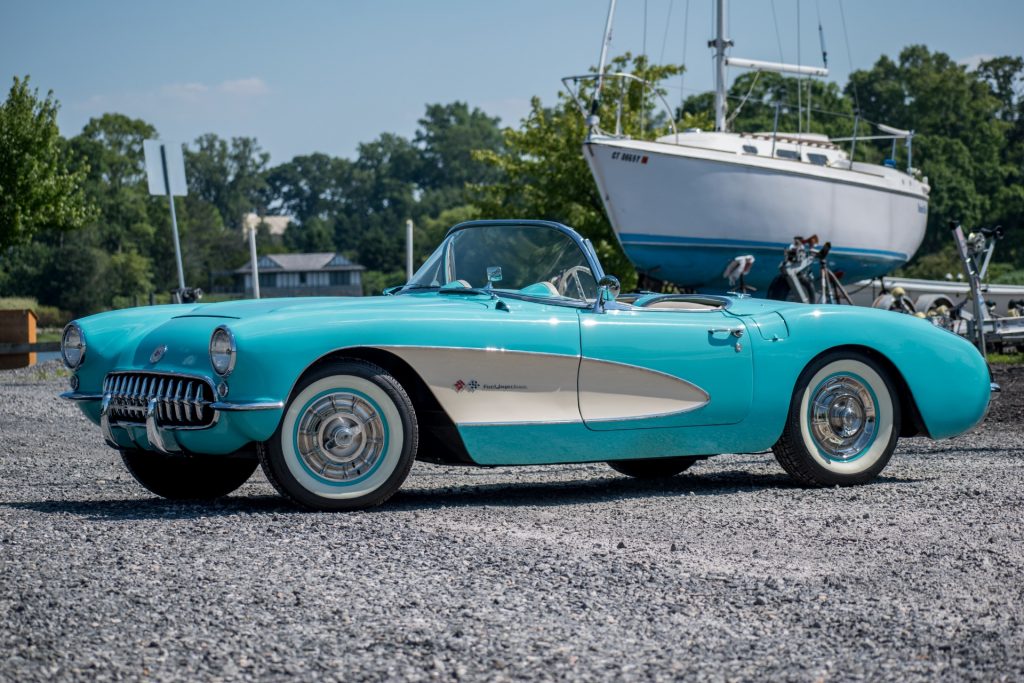
One of the few ways to differentiate between a 1956 and a 1957 Corvette without opening the hood is to look at the inside rearview mirror. On the 1956 Corvette model, the mirror adjusts with a thumbscrew, whereas in 1957, the rearview mirror adjustment requires a wrench to loosen the locknut.
A new, larger 283-CID engine was placed under the hood, Mechanically, it was really still the existing 265-CID engine, though it had been bored out 1/8-inch (to 3.875 inches). This modified engine delivered an impressive 220 horsepower when coupled with a four-barrel carburetor. Dual four-barrels took it to 245 horsepower (and 270bhp.) Better still, consumers could now also purchase GM‘s newly developed “Ramjet” fuel injection system which yielded 259 horsepower (or 283 bhp).
To provide greater handling and stability, Chevrolet also issued RPO 684 – a heavy-duty racing suspension package. This option, priced at $780.10, included heavy-duty springs, a thicker front anti-sway bar, the aforementioned Positraction rear end, larger piston shock absorbers, a tighter steering ratio that reduced turns lock-to-lock from 3.7 turns to only 2.9, and ceramic/metal brake linings with finned ventilated drums.
1958 Corvette
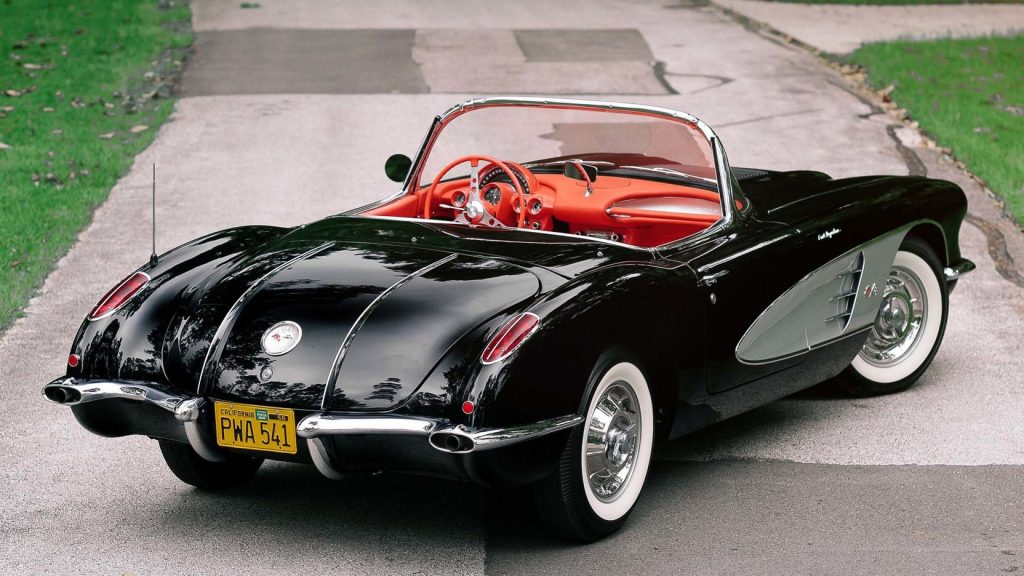
The 1958 Corvette was far more excessive than any of its predecessors. While the car still reflected the design changes implemented in the 1956 and 1957 models, the ‘58 Corvette now sported simulated louvers on its bonnet (hood), non-functional air intake scoops on either side of the grille, and phony vents in the bodyside “coves”. It also featured twin, chrome “suspenders” that ran from the base of the rear window down the trunk lid, before ending abruptly at the rear fender. Another notable departure from the earlier models was the addition of quad headlamps wrapped in a thick chrome bezel.
Much like the chrome “suspenders” featured on the trunk lid, a chrome strip ran along the tops of the fenders, accentuating the appearance of the headlamps and giving an overall “swept back “ appearance. Lastly, the chrome “teeth” in the front grille itself were reduced from thirteen (as had been the standard in all Corvettes prior to 1958) to only nine. The 1958 Corvette not only looked heavier with its many new additions and design changes, but it had actually gotten heavier.
For the first time in Corvette history, the car exceeded 3,000 pounds, which was an increase of 200 pounds over the 1957 model. However, the increase in weight was not merely due to the excesses that were included in the car’s makeover but was the result of the increased size of the car. The 1958 Corvette had 9.2 inches of added length and 2.3 inches of added width, bringing the car’s overall dimensions to 177.2 by 72.8 inches.
A significant redesign of the instrument cluster at the request/direction of Zora Arkus-Duntov resulted in all of the gauges (save for the clock) to be placed directly in front of the driver in a binnacle. The new cluster consisted of a 160-mph speedometer which dominated most of the dashboard, while a smaller 6000 rpm tachometer was placed ahead of it on the steering column. Flanking the tachometer on each side was a pair of standard instrument gauges that monitored fuel levels, oil pressure, engine temperature, and battery charge.
Now officially rated at 290 horsepower (at 6,200 rpm’s), the fuel-injected, Duntov-cam 283 continued to flourish beneath the hood of the 1958 Corvette as the top-level engine for that year’s model run. A twin-carburetor version of the engine continued to be offered as an option, offering drivers an uncompromising 270 horsepower engine. Despite this fact, few buyers opted for the carbureted version of this engine. Surprisingly, it was the base level 230 horsepower V-8 engine that buyers sought out.
1959 Corvette
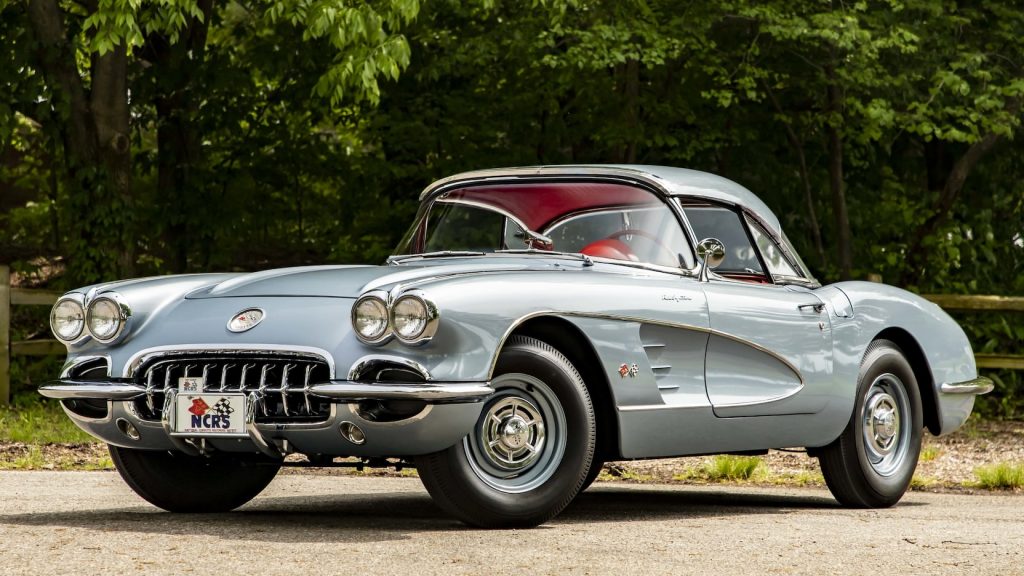
The 1959 Corvette was “cleaned up” considerably. For one, the chrome “suspenders” were removed from the design, providing Corvette with a more swept-back look that was synonymous with speed. For another, it was decided that the faux hood louvers would be eliminated, returning the Corvette to a semblance of its former self.
The interior received minor, but significant updates. Both the door handles and the armrests were repositioned and a small-item storage compartment was added beneath the passenger side grab bar. Both the driver and passenger seats were redesigned to offer increased lateral support to their occupants. All tachometers now indicated up to 7,000 rpm and offered redline and safe limit indicators. Sun visors were introduced to the 1959 Corvette as a new option and concave instrument lenses replaced the flat covers of the 1958 Corvette to reduce sun glare.
The 1959 Corvette was the only production year where Chevrolet included an option of purchasing a turquoise soft top. Also, the 1959 Corvette marked the first year where consumers could purchase an all-black interior.
1960 Corvette
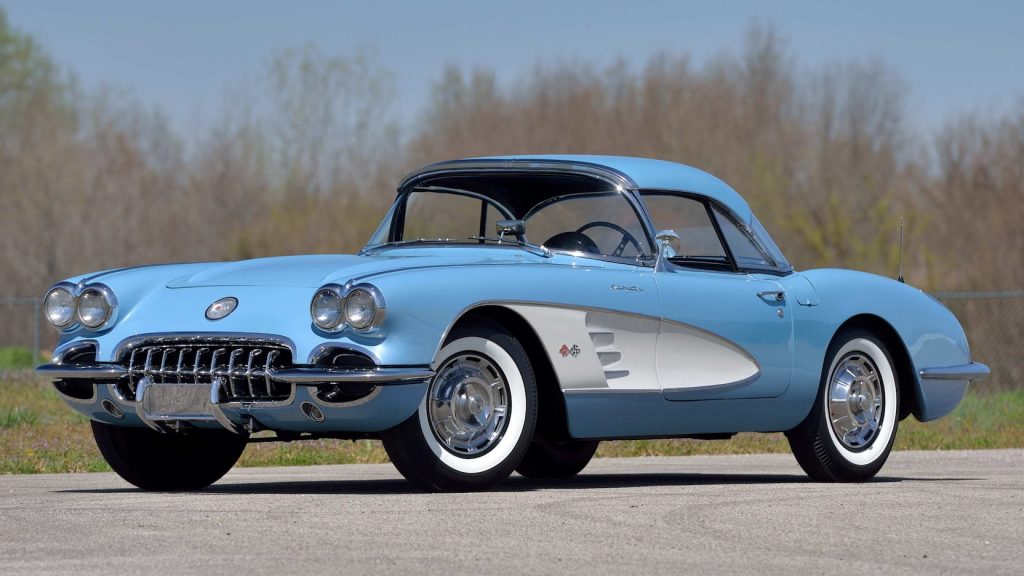
From a design standpoint at least, the 1960 Corvette is virtually indistinguishable from 1959. The body lines and chrome trim is nearly identical on both models. The interiors have virtually no distinguishable differences. In short, the 1960 Corvette was, for all design purposes, a continuation of the 1959 production model.
However – the top two engines, both fuel injected or “fuelie” engines, received an increase in their overall horsepower. The addition of solid lifters and a higher, 11.0:1 compression ratio boosted the strongest of the fuelie engines to 315-bhp at 6,200 rpms. The second most powerful engine included hydraulic lifters (which made for easier maintenance) and pumped out an impressive 275-bhp at 5,200 RPMs.
Standard options for the 1960 Corvette included the introduction of a larger-diameter front anti-roll bar matched and a new, heavier duty rear bar. These changes, plus an extra inch of rear-wheel travel in rebound produced a smoother riding, more neutral handling Corvette than ever before.
The 1960 Corvette was the first Corvette to use Nylon Belted Tires (a type of tire that is still sometimes used today, though not as durable as a steel-belted tire).
1961 Corvette
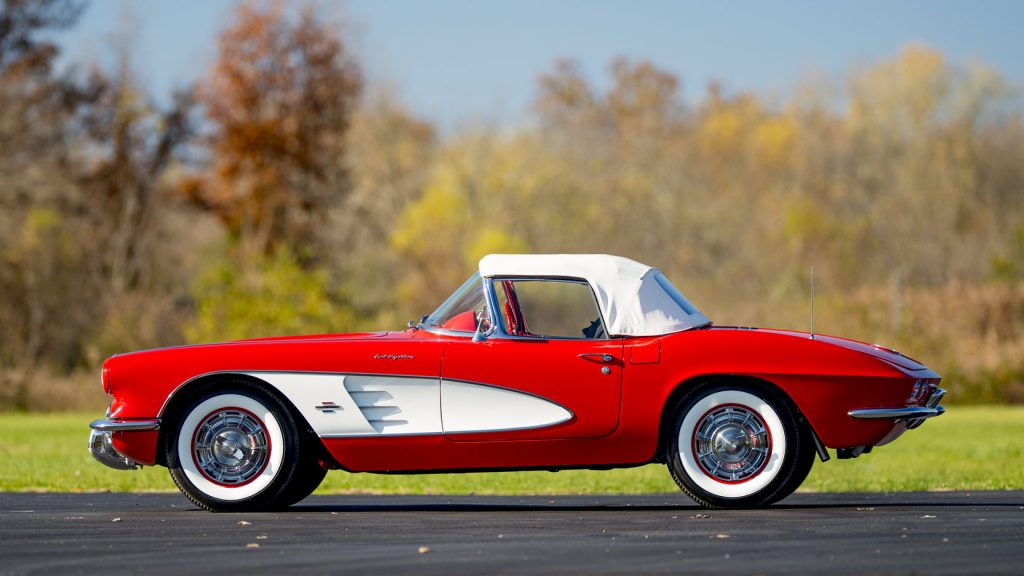
General Motors executives decided to “green light” a restyling of the Corvette for the 1961 model year. The most pronounced change was the introduction of a freshened rear-end design. The “ducktail” design (as it has become known amongst Corvette enthusiasts) was virtually lifted from the Stingray race car as well as Bill Mitchell’s XP-700 show car. The redesign of the rear end of the Corvette enabled an increase in available luggage space by twenty percent (20%). The new rear end also showcased a pair of small, round taillights on each side of the license plate recess.
On the front end of the car, Chevrolet introduced a redesign of the dual headlamp system, providing Corvette with a more streamlined version of the existing four lamp nose. Headlight bezels were no longer available in chrome but instead were painted to match the rest of the body. Likewise, the chrome “teeth” grill was replaced with a fine wire mesh insert that was finished in argent silver.
The round Corvette emblem that resided on the front nose of the car was replaced with individual block letters that spelled out the car’s name. This was topped with a larger version of the Corvette’s crossed-flags insignia.
The interior of the 1961 Corvette went virtually unchanged from its predecessors. To increase space within the two-seat cockpit, the transmission tunnel was slightly narrowed, though this single change did little to affect the overall appearance of the car‘s interior.
The 1961 Corvette would be the last Corvette to offer a consumer the option of purchasing bodyside coves in contrasting paint colors. The 1961 Corvette was also the last model year to offer the option of “wide” whitewall tires as well as the last model year to offer the 283 cubic inch V-8 that helped launch Corvette into stardom!
1962 Corvette
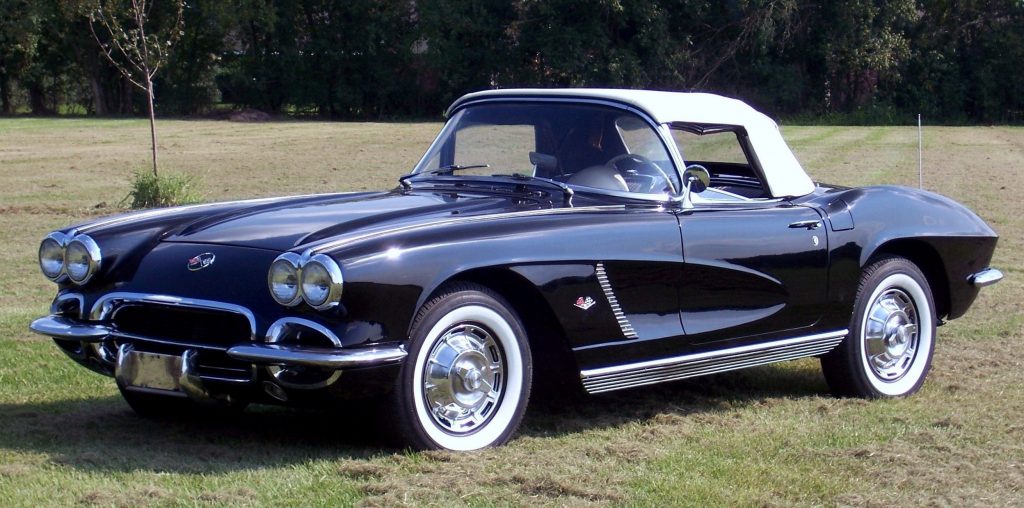
The 1962 model year represents the end of the first-generation era for the Chevrolet Corvette.
The 1962 Corvette was the first model year to incorporate the 327 cubic-inch V-8 engine in place of the smaller 283 cubic inch engine. Though technically the same engine block as the 283, the smaller engine was bored and stroked to bring its cylinder dimensions to 4.00 x 3.25 inches and it’s displacement up to 327 cubic inches.
The 1962 Corvette was stripped of any of the remaining excesses that had plagued it’s earlier counterparts. The most obvious of these deletions was the removal of the chrome outlines that had framed the body side coves since 1956. Further, the chrome accent spears (that had accentuated the side vents within the coves) were also removed, replaced instead by more conservative aluminum blades that were finished in black. Another omission which added to the more cohesive look of the car was the deletion of the option to have the coves painted in a different color than the rest of the car.
The C1 Buyer’s Guide
As you can probably distinguish from the images above, the first-generation Corvette can be further divided into four, unique subdivisions – 1953 to 1955, 1956 to 1957, 1958 to 1960, and 1961 to 1962. While we’ve already covered the unique features of each model year, one of the first considerations someone thinking of buying a C1 Corvette should make is which version of the car is right for you? Are you a fan of the original design? If so, then you also need to be aware that many of the earliest Corvettes only came equipped with a 250HP six-cylinder engine. Are you looking for bigger horsepower and a more track-capable example? You’ll want to consider some of the latter year models.
Regardless of which example of the car you decide to consider, there are certain items that remained virtually unchanged from 1953 to 1962. Even those elements that have changed, such as the contour of certain body panels, the number of headlights, etc., most of the information contained in this buyer’s guide is designed to give you key items that you’ll want to closely examine before making a purchase. This guide is not all-inclusive, but rather a good starting point for getting familiar with your future first-generation Corvette. As always, we strongly encourage you to have any car you’re thinking of purchasing looked at by a professional mechanic. This holds especially true on vintage cars of this nature – while there are many amazing examples available, there are just as many that have been molested, abused, and not well-maintained. Because of this, and because cars from the 1950s and 60s aren’t as well documented as cars of today, being vigilant during the buying process will save you a lot of time and money later on.
Chassis
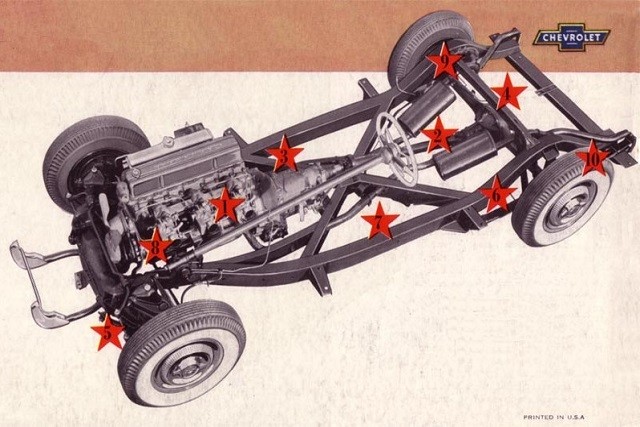
One of the most common items overlooked by prospective Corvette owners is the fact that all Corvette bodies are made of fiberglass. Because of this, the outward appearance of a Corvette – even one that is decades old – may look much newer than cars with conventional steel bodies. While the bodies of Corvettes may be made of fiberglass, the underpinnings of the car are not.
When inspecting a Corvette for purchase, take time to get the car on a lift and carefully examine the frame assembly for rust. Look at any points where two or more pieces of the frame are welded together. Make sure the welds are solid (not cracking) and that they appear free of pitting or rush. Be thorough in this inspection process. Even if just one section of the frame is rusted/corroded away, it can be a costly repair.
In addition to corrosion, look for damage to the frame. If it has been bent, crushed, twisted, or damaged in any way, this should be readily apparent during the inspection. Look for sections of the frame that mismatch one another. This could indicate that the frame was previously repaired/modified.
Body Panel Bonding Strips
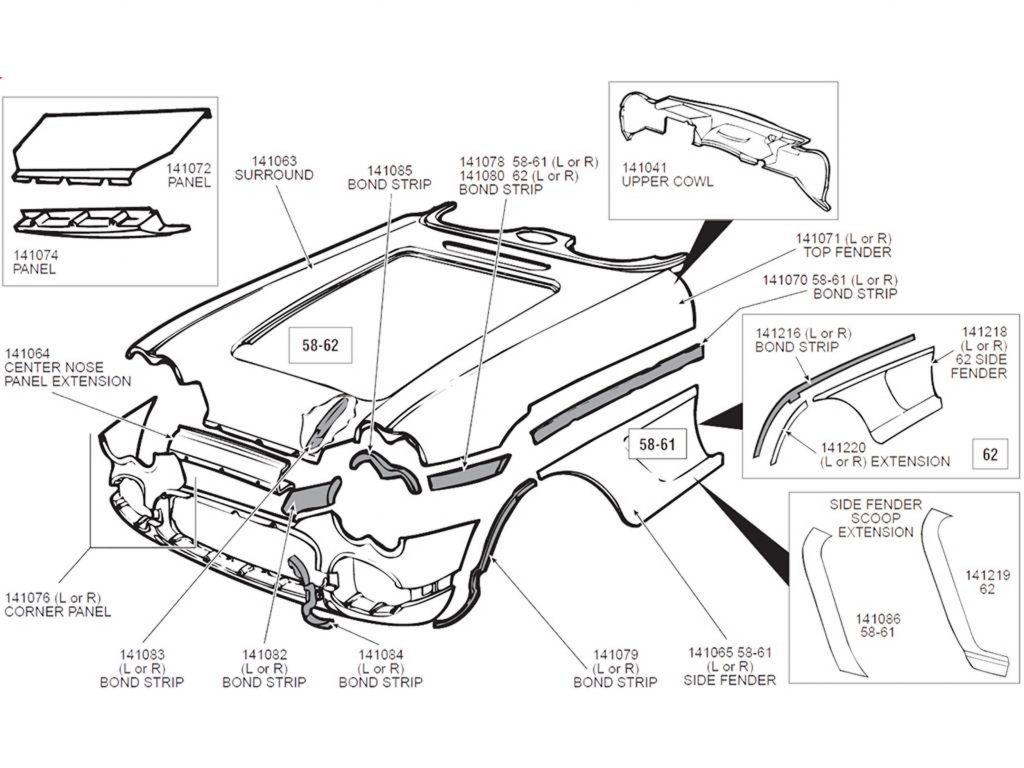
While you’ve got the car up on a lift, take time to inspect the internal side of the car’s fiberglass body panels. Also, take time to inspect the body panel bonding strips. When the fiberglass body of the Corvette is assembled, many of the body pieces are held together via the use of lengths of fiberglass commonly referred to as bonding strips. Inspection of the bonding strips is another easy way to determine if a car has had bodywork done to it. In such cases, the strips holding the panels together will appear mismatched and/or you’ll see areas where bonding strips may have been removed entirely.
In addition to the bonding strips, look closely at the interior of the body panels. If you see a discrepancy between the fit and finish of the fiberglass, it could be an indicator that the car has had some bodywork done. This doesn’t necessarily mean its been in an accident, but it is worth investigating further if your findings do indicate that panels have been removed and replaced.
Body Panel Fitment – Hood, Trunk, Doors and Fenders
Moving to the exterior of the car, look closely at the gaps between various body panels. Uneven gaps between doors and fenders, fenders and hood, etc., are strong indicators that the car has had bodywork done to it. It is often an indicator that the car has been involved in an accident.
That said, it is equally important to remember that these cars are 60+ years old. Many of the precision standards used in manufacturing today did not exist when these cars were being assembled. It is possible that the individual Corvette you are looking to purchase may have variances in the width of the body panel gaps. It is also possible that, over the course of time, panels have shifted due to less dramatic events – heat expansion (from sitting in the sun), contraction (from exposure to cold), aging of the bonding strips, etc. Anyone or more of these can cause panel fitment to shift over time.
Additionally, the current owner of the car may not know the complete history of the vehicle (especially if he/she is not the original owner.) It is important not to accuse the owner of misconduct as they may be unaware of any bodywork ever being done to the car since it came into their possession. As most owners take great pride in their Corvettes, it is important to remember to address these types of items with a degree of discretion when questioning the history of the car.
Fiberglass Stress Cracks
We mentioned the impact that environmental factors can have on body panel fitment above. The same holds true for the aging of fiberglass. Like all materials, fiberglass is prone to age over time. Due to the chemicals available at the time the early Corvettes were being produced, the ability to seal fiberglass was also limited, meaning it was more prone to pitting and cracking than more contemporary examples of the car.
When inspecting any C1 Corvette, look closely for pitting, cracking, or other imperfections in the fiberglass body. Be thorough and look underneath the lips of the cars wheel wells, along the leading edges of the doors, windshield posts, underneath the rear decklid, etc. Take time to examine every component thoroughly.
Keep in mind that some aging is bound to occur on any car from this era. Even cars stored in climate-controlled environments could show indications of body panel aging. It should definitely not be a deal-breaker. Where caution comes into play is directly related to the number of stress cracks or blemishes that are found during an inspection. Should an inspection reveal the significant deterioration of the car’s body, it could indicate that the car was exposed to the elements for a prolonged period of time. Long exposure to UV radiation, extreme heat and cold, even prolonged exposure to moisture (over years) can lead to the eventual deterioration of the car’s body panels and, as such, it is important to be thorough in your examination of the car.
VIN Numbers and Completeness
These next two items are more subjective to the buyer’s individual preference. However, they are worth considering. First, verify engine casting numbers, transmission casting numbers and VIN numbers.
If you are looking for a numbers-matching car or, put another way, an original, unmolested example of a particular Corvette, this will be of particular importance to you. Because so many Corvettes have had engines swapped, replaced, modified, etc., many of the early examples of these cars now feature a powertrain that is different from what originally came in the car. Even if the engine is the same displacement, it could be a crate engine that replaced an engine that failed sometime in the past.
A “numbers matching” car (the VIN and engine serial numbers match) is worth 20-30 percent more than a Corvette that has been altered. It is important to keep this in mind when negotiating a price for your would-be Corvette.
Second, keep in mind that many vintage Corvettes will NOT be numbers-matching, and that’s also completely okay! Number matching Corvettes became a bigger deal as the NCRS (National Corvette Restorers Society) began judging Corvette restorations based on their completeness. Over time, the stigma of a “numbers matching” car became one of the highest judging criteria of that organization.
It is important to remember the reason YOU are purchasing a Corvette. If you are looking for a car strictly to compete in car shows or the like, then having a numbers-matching car may be the way to go. However, if you are looking for a weekend cruiser, or a project car to restore and call your own, then the significance of having a numbers-matching car goes down appreciably. There are plenty of non-numbers matching cars out there that are well-built cars that promise an amazing driving experience that will bring a smile to your face for many years to come.
One item that tends to cause issue/concern among Corvette enthusiasts is coming across a Corvette that has been re-painted a different color. Once again, this is not necessarily a deal-breaker, but color change on a Corvette is a major detractor from the standpoint of re-sale, so it should be taken into consideration prior to purchasing.
Get a Used Car Check
Take time to have the car checked by a reputable mechanic (either at a dealership or a trusted service garage). Ask them to check the vehicle’s fluids, perform a compression test on each of the cylinders, check the brakes, the steering linkage, the cooling, and electrical systems, and the safety restraint/airbag systems to ensure that everything on the car is as it should be. While you’ll probably have already inspected a number of these items yourself, having a trained professional verify your findings will provide you with greater peace of mind before handing over your hard-earned dollars for a used sports car – even one as nice as a Corvette!
Take It For a Test Drive
After you’ve done all of your homework, its time to get your prospective Corvette out on the open road. The test drive will allow you to experience the car in a way that no inspection ever could. It will help you determine whether or not the car is a good fit for you as a driver. Even a perfectly maintained Corvette isn’t going to be of value (or enjoyment) to you if you aren’t comfortable driving it. For some perspective owners, a first-generation Corvette might sit too-low-to-the-ground, or the cockpit might seem too compact (keep in mind these cars are all two-seat sports car with no backseat and limited storage space, especially in the convertible models.) For others, the ride may be too harsh, or the exhaust and/or road noise might be too loud.
It is important to remember that the C1 Corvette evolved considerably from its introduction in 1953 to the end of its production in 1962. We recommend you drive several different examples – while they’re all based on the same platform, you’ll be surprised how different each year is from the others.
Also, the test drive is another means of checking the car’s operability. When driving the car, don’t allow the passenger (which will probably be the car’s current owner) spend the entire drive talking at you or with you. It is important that you listen to the car. Pay attention to any clunks, engine or transmission noises. Also, take enough time to really put the car thru its paces. Observe if the car wants to pull to the left or right. Be intentional about testing the brakes and the steering. If it is a manual transmission, pay attention to when the clutch begins to catch – if it’s got a high clutch pedal, it could indicate that the clutch is worn out. Look for smoke coming from the exhaust or beneath the hood and pay attention for any unusual smells – such as burning oil or engine coolant.
Be Patient – Take Your Time!
For most of us, buying a Corvette is an emotional experience. It’s a promise that many of us make to ourselves when we see our first Corvette that “someday I’m going to have one of my own.”
If you are in the market to buy your first (or next) Corvette – CONGRATULATIONS! This is an exciting time for you, and it is understandable that you’d want to find the “perfect” car to bring home and have forevermore. However, you must practice patience when shopping for a used Corvette. Just as you dream of countless hours enjoying the back countryside and the open road, the people who purchased the car you are now looking at dreamed the same dreams. As such, finding the right Corvette is a little different than buying a “daily driver” that you’d use for your commute back and forth to work. These cars are driven harder, faster, and often with less regard to the wear and tear than to the exhilarating experience of flying thru a sharp turn just a little too fast.
Because of this, you’ll want to follow all the steps we outlined in this article. You’ll want to keep emotion out of the decision-making process as much as is humanly possible. That’s not to say you shouldn’t enjoy the experience, but be informed and purchase a Corvette that passes all these search criteria so you’ll have as much enjoyment with your Corvette after you make the purchase as you did finding it in the first place. It is also worth noting that shopping for a Corvette can be a lot of fun! You’ll definitely get to drive some amazing cars along the way…and here’s where you should embrace and enjoy the journey of finding the “perfect Corvette.” If nothing else, you can be certain that when you do finally make your big purchase, you’ll have found a Corvette that is perfect for YOU.
Anticipate Ownership Costs
There is one other item worth considering when purchasing a 60-year old Corvette. This car is likely not going to be your primary means of transportation and, as such, this car will not be driven daily. Make sure you’ve got sufficient space to store your automobile. Additionally, you’ll want to contact your insurance provider to determine the cost of insuring a Corvette. Keep in mind that the amount of anticipated mileage to be driven each year will influence the cost of insuring the car. Lastly, remember that even the best-maintained Corvettes will require some amount of maintenance, so evaluate the costs associated with vehicle maintenance and verify the affordability of the car before committing to its purchase.


